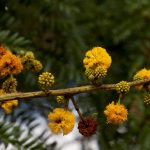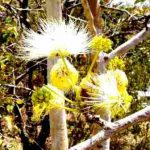TREE LIFE
AUGUST 1995.
MASHONALAND CALENDAR
Saturday 5th August. Botanic Garden Walk at 10.45 a.m. for 11 a.m. We will meet Tom in the public car park of the Gardens, where there will be someone to guard the cars. This, the fourth, may be the last in the current Acacia series. So far Tom has shown us those with prickles, scattered prickles, the glandular group and a few of those with straight thorns.
Sunday 20th August. Member of the Wildlife Society will be joining us when we revisit Ngomakurira. This is a fascinating mountain and we should look out for flowering aloes at the base of the hill, progressing to Eastern districts species such as Oxyanthus speciosus, Rapanea melanophloeos and Trema orientalis as well as Tricalysia ruandensis, which we recently found at Domboshawa. On our last visit in June 1991, we recorded 119 species. We plan to meet at 9 a.m. for an early-ish start because the days are shorter and the evenings quite cold. The walk will be a leisurely one, stopping to look at the rock paintings on the way. Wear walking shoes and bring a portable lunch for a picnic on the summit.
Saturday 26th August. A look at Eucalyptus with Lyn Mullin at 2.30 p.m. at the Forest Research Centre. Bring a x10 lens and Lyn’s paper – Eucalypts in Harare if you have them.
Tuesday 5th September. Botanic Garden Walk and back to our evening walks with the return of longer and warmer evenings.
MATABELELAND CALENDAR
Sunday 6th August. Focus on Combretaceae in and around Bulawayo.
Sunday 3rd September. Depart from Girls’ College Car Park promptly at 8.30 a.m.
Extra. Continuing with David Attenborough’s The Private Life of Plants on the 2nd Monday of each month at 7.45 for 8 p.m. at Girls’ College.
The next, on Monday 13th August, will be episode 3 – Flowering.
Then episode 4 – Social Struggle
Episode 5 – Living Together
Episode 6 – Surviving
Friday 29th September to Sunday 1st October. IKOROS SAFARIS, West Nicholson. Limited accommodation (12) therefore 1st come first served. Please get details from Ian McCausland.
First week-end in November. In search of Oreobambos buchwaldii on Buchwa Mountain.
Greystone Nature Preserve
Things continue despite the dry season. We are still cutting out the exotics especially the Poplar. The main problem is the lack of workers (If anyone can help in this respect please contact Rob Burrett at St. George’s and leave a message if Rob is in class). Our next gathering in the Preserve is 5th August at 4.00 p.m. We wish to review work done to date and unveil new projects to come. Tree Society members will be more than welcome.
BOTANIC GARDEN WALK: 1 JULY 1995
Acacias part 3. This month, Tom started with a distinct group, the Glandular Acacias, so called because they have glands on their pods. All have straight thorns and yellow spherical flower heads.
Four species occur in Zimbabwe: Acacia borleae, Acacia exuvialis, Acacia nebrownii and Acacia permixta.
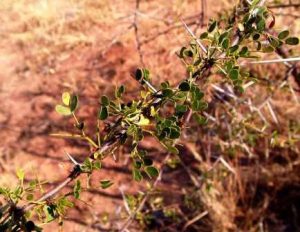
Acacia nebrownii. Photo: Rob Burrett. Source: Flora of Zimbabwe
Acacia nebrownii was the first examined. In Zimbabwe, it occurs only in the south. It is a shrub, never really a tree and the flowers have a distinct fragrance detectable from a distance. There are relatively few pinnae (1 pair, rarely 2) and leaflets (3-5 pairs).
Acacia permixta. In this species, the young twigs are densely hairy (glabrous or sometimes glandular in Acacia nebrownii) and there are usually many more pinnae (1-4 pairs) and leaflets (5-10 pairs). Like Acacia nebrownii, in Zimbabwe it is found only in the south. At the Tuli Circle, it appears to intergrade with Acacia borleae.
Acacia borleae not only has glands on its pods, but also on its leaflets. It is a shrub, lacking the hairs of Acacia permixta. This species is the only Glandular Acacia to have been recorded from the northern division of Zimbabwe, although it also is to be found in the southern and eastern ones as well.
The last glandular species is Acacia exuvialis, which has been placed in quotes because Tom has doubts that it is really Acacia exuvialis. Our plant lacks the flaking bark of true Acacia exuvialis from the Transvaal and also has brown twigs (dark grey in the Transvaal specimen). Whatever its name, it occurs on rocky basalt slopes in Gonarezhou.
Having finished the glandular species, we looked at a number of other straight-thorned species.
Acacia arenaria occurs in the west country, i.e. Matabeleland and in the Beit Bridge area and, outside Zimbabwe, in Botswana. It is also a shrub, often multi-stemmed; it possesses numerous small leaflets and has curved pods.
The specimen of Acacia hebeclada in the Gardens had thorns that were distinctly curved. It has greyish fine leaflets and looks a little like Acacia gerrardii but differs in that the pods, remarkably, stand bolt upright.
Acacia robusta ssp. robusta has chunky branches, is somewhat similar to Acacia karroo but has relatively few pinnae and broad pods. It is a true climax species of Matabeleland and is never riverine. The branches are distinctively marked with clusters of old leaf bases.
Adjacent to this is Acacia robusta ssp. clavigera, which Tom feels should be treated as a separate species and not merely a different subspecies. This is a truly riverine species, although sometimes finding its way into Jesse bush. The pods are much less stout and are usually more curved.
Similar in leaf to robusta is Acacia grandicornuta, which in Zimbabwe is confined to the SE. In many ways it is similar to Acacia karroo bur lacks the reddish-brown underbark of that species.
Finally, we looked at two more familiar species. Acacia karroo has leaves like robusta, black bark and rusty-red underbark on the younger branches. The pod is sickle-shaped. It often occurs along rivers.
Acacia gerrardii has grey, velvety, slightly curved pods, a bit broader then Acacia karroo. It may have a mixture of long end short thorns and furthermore, these may be somewhat curved.
Once again, our thanks to Tom for a fascinating walk among the Acacia beds.
-Mark Hyde.
IVORY SAFARIS: 16-18 June 1995
Our weekend at Ivory Safaris was an extra that we worked into our calendar for the second half of 1995. We did not advertise it as a botanical outing as both of our experts on Northern Matabeleland were out of the country – Jonathan Timberlake somewhere in England and Anthon Ellert at a conference on succulents in Tucson, Arizona, where he is due to present two papers on the Aloes of Zimbabwe.
Nevertheless, for those who were sufficiently enthusiastic, there was a bush walk on Saturday morning that had a strong botanical bias and some fairly intensive investigation of the tress and shrubs in and around the camp on our return from the walk.
In the absence of Jonathan and Anthon we co-opted local expertise in the persons of Livingstone and Mike, tour guide and manager at Ivory Safaris respectively and in desperation specimens were taken for identification to Mike’s wife in the kitchen. In this fashion we were furnished with either Shona or Nde
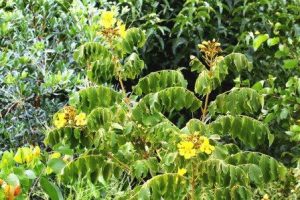
Markhamia obtusifolia. Photo: Bart Wursten. Source: Flora of Zimbabwe
By these means we discovered amongst other Markhamia obtusifolia (five pairs of leaflets as opposed to 3 in Markhamia zanzibarica and a terminal leaflet of about the same size and shape as the rest), (Ndebele- lpanda). Diospyros mespiliformis (which we should have known albeit somewhat different from the Matopos variety – Ndebele name Umdlawinzo).
We reacquainted ourselves with Amblygonocarpus andongensis, Erythrophleum africanum, Ziziphus abyssinica and some of the common species of the Kalahari Sand such as Baphia massaiensis and Friesodielsia obovata (so like Bridelia mollis but for the recurving lateral veins). For the most part however, our time was spent either on game drives or eating Ivory Safaris excellent food.
It was a wonderful relaxing weekend and interesting to see the camp in the dry season – so very different from the jungle we walked through in February 1994.
Mike Burton was a splendid and generous host and his staff who were friendly and considerate made us feel quite at home. I have no hesitation in re-awarding five stars to Ivory Safaris despite the fact that we saw no wild dog.
-I McCausland
PALM BLOCK AT THE NORTHERN END OF THE GREAT DYKE (ZIMBABWE)
At a combined meeting with the Aloe, Cactus, Cycad and Palm Society to the ‘Palm Block’ on Sunday 18th June 1995 those present were fortunate to be treated to a lecture by Frik Morris the palm ‘ fundi ‘. The area is unique where the giant raffia palms extend their leaves to some 18 metres, the largest leaf in the world. The palms are multi-stemmed (hapaxanthic) with the trunk less than 2½ metres. The long leaves overlap around the stem and have a greyish silver appearance, going to pink before forming feathery green fronds. Described by one member, so aptly, as giant fennel plants. Dwarfed by these long swaying fruits with their filigree fluttering leaflets gave a feeling of having gone back aeons in time.
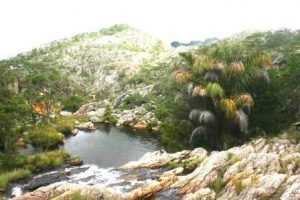
Raphia farinifera. Photo: Bart Wursten. Source: Flora of Zimbabwe
The Raphia palms (Raphia farinifera) had created their own microclimate and were growing in profusion along the streams, beyond where the stream erupted as a water spring, the palm growth stopped. According to Coates Palgrave the palm is essentially of swamp areas. The soil was black, fibrous, and rich in organic matter, humus and smelt acid. Growing in the area were plants associated with Nyanga and high rainfall Cussonia spicata, bracken and a bramble species that might have been rigidus because it was stiff and scratchy. The altitude was not the factor because this locality was 1240 metres. Numerous seedlings had germinated and were usually caught up and protected by decaying pieces of dead fruiting body or rachis. Other plants had propagated from stolons as suggested by the observation that these young plants ware not perpendicular but angled towards a parent plant growing in close proximity (7-8 metres away).
The fruiting bodies were huge inflorescences that were grey and scale-like hanging some 15 metres from the ground and probably some 2-3 metres in length. These resembled giant ‘cones’ and hung below the plumes of arching leaves. The difference between the two species of Raphia is that the flower heads of Raphia farinifera start erect and later bend over and hang down below the leaves. Raphia australis is of a more southern locality as its name indicates, occurring in Mozambique and Northern Zululand. The flower head is kept vertically above the crown of leaves.
Erik Morris queried whether this was significant enough to create two separate species. The Raphia australis is referred to as the Kosi Bay species and at the turn of the century a magistrate planted a grove of these trees in the Mtunzini area. The grove by the Railway station, which was the site of the original planting, has been declared a scientific monument. Where the palm occurs in Mozambique the giant petioles are buoyant and are made into outriggers for their canoes.
Raphia farinifera also occurs in Madagascar, the Horse Shoe Block, in the Vumba and Masvingo. It could have been brought by the Arabs or from Madagascar. More likely the Arabs, not because they are blamed for the slave trade but because the palm is prized in their poetry and culture. The fruits are eaten by a vulturine eagle that does not occur in Madagascar and could not have been responsible for the distribution. The large size of the seed would render it physically impossible unless it was the famed bird of ribald student songs. The bird is the palm-nut vulture (Gypohierax angolensis) resembling a small hooded vulture. It is not found in Zimbabwe but along coastal forests and large rivers and northwest of the Okavango Delta but always in the vicinity of Raffia palms. The single seed is large, about 10 cm long, has conspicuous overlapping scales, very shiny and golden brown. The palm vulture would tear off the woody scales with its talons to get out the white coconut like meat beneath. The inflorescences take 2 – 3 years to develop.
The palms are flowering seed bearing plants, Angiosperms and are monocotyledon, which means the floral parts are arranged in threes and the leaves, are linear with parallel venation. The male and female flower parts are not in the same flower but found in separate flowers and are referred to as monoecious (one house). The sepals and petals are tubular and the ovary oval and single chambered (monocarpic).
The inflorescences formed tight overlapping scales and it has been said the male and female flowers occurred on the same inflorescence with the male flowers at the bottom of the giant reproductive structure. Observation did not suggest this because there were numerous male-type dried structures and scales on the ground. The ripe swollen seeds could be seen in profusion on their huge cone-like structures hanging from the palms. It is possible each inflorescence is either male or female on the same tree but matures at different times. A newish tightly arranged giant grey reproductive body was seen to have some of its scale-like parts open. The mature reproductive bodies were not tightly closed and the seeds hung protruding from the scales. How fertilisation occurred is not known, it could be wind, insect, e.g. small beetles or even by bats.
Those massive palms are short lived and after about 25-35 years they flower, set fruit and the tree starts to whither and dies. When a high wind catches the giant superstructure it crashes to the ground scattering seed over a fairly wide area but providing a tiny micro¬climate in the fibrous leaves and scale like parts of the giant inflorescences. These provide protection and a mini greenhouse.
With the Ilala palm or Northern Ilala palm Hyphaene petersiana (Hyphaene benguellensis) fruits are produced in large quantities up to 2000 and take 2 years to develop and 2 years to fall. The fruits are eaten by elephants and baboons but contrary to the story told to tourists the fruit does not have to pass through the gut of an elephant to germinate. These germinate anywhere there is moisture and warmth. The myth about the elephant’s gut is not entirely unfounded because in the Zambezi Valley the elephants destroy trees which when fallen trap grass and elephants’ dung forming a microclimate or miniature greenhouse.
In the Raffia palms the germination is adjacent with a brittle little radicle and a yellow white shoot comes off the hypocotyl and turns green and is called the eophyll.
Palms hate being dug up and transplanted because the roots should not be disturbed. If purchased from a nursery the bottom of the black plastic bag should be cut away and slits cut in the sides of the bag. Leaves should not be cut back to prevent water loss by transpiration and the young palms should be watered but not over watered. Palms should be planted in large holes 2 metres by 2 metres which are filled with rich compost and mixed with bark. Germination is enhanced by the ecosystem at Palm Block, where leaf mould and humus was abundant. Germination and growth is promoted by using liquid seaweed and also by preparations containing magnesium, nickel and chrome in soluble form for the Raffia palms.
Palms like the Phoenix palm or wild date palm Phoenix reclinata, which has a reclining habit grows in swamps and produces breathing roots like man¬groves called pneumatophores. These palms can grow in a wide range of conditions and are easy to grow and propagate making excellent garden plants. The fruit bats feed on the yellow overripe fruit dropping seeds which germinate on flower beds or anywhere the soil is rich and moist.
Zimbabwe has four indigenous genera of palms, the Borassus palm, two species of Hyphaene, Raphia and the Phoenix palms.
Like the fan-like Hyphaene, the Borassus palm has a very straight stem or bole but with a characteristic swelling midway. In the Tzaneen area it was believed the swelling of a large Borassus palm had entrapped the spirit of Magoeba when he was murdered. The belief that an ancestral spirit can linger in a tree is not uncommon in Africa. Chiefs have been laid to rest beneath the mighty baobabs. In Mozambique the boles of the Borassus palm are fashioned into dugout canoes. Borassus palms occur at Renco Mine.
The uses of palms are fascinating. The hard wooden insect resistant rachis of the raffia palm makes beautiful furniture and probably roof tiles. In East Africa thatching is done by taking the leaflets of the coconut palm and knotting them next to each other on stick of half a metre. The sticks are laid like tiles on the roofs of coral brick houses and referred to as ‘makuti’.
The sap of palms is made into intoxicating wine but the cutting of the crown eventually kills the palm. The crowns of young palms can be eaten as a delicacy or aphrodisiac.
The leaves can be made into raffia, fashioned into rope or woven into baskets. The Hyphaene produce an inferior vegetable ivory used in carvings and buttons. The sap bled from the Hyphaene is slightly intoxicating and a tree can yield up to 70 litres. The liquid can be distilled to make a very powerful brew. The species have massive tap roots acting as an anchor for the height and to locate water in the dry areas of the Zambezi Valley. The long tap root makes transplanting difficult. When germination occurs adventitious roots form rapidly from the dying hypocotyl to hold the seedling.
Another interesting feature about palms is the association of palms and the palm swift Cypsiurus parvus. The very slender streamlined little swift with very long tail feathers can be seen whirling and calling amongst the fan palms of Harare and in particular along Julius Nyerere. The long tail feathers are neatly kept closed, looking pointed, allowing easy access into the dead palm fronds. A characteristic of swifts is that they have large salivary glands. The palm swift uses saliva to glue feathers to the palm fronds for a nest. The two eggs are glued to the fronds with saliva. It is thought there is no need for the eggs to be turned because of the rustling and motion of the dead palm leaves. The long leg claws of the chick enable it to cling on to the frond and hang there safely above the bustling city traffic beneath. Swifts have large forward facing feet with big toes and have great difficulty in getting airborne once on the ground.
-Mary Toet
FORESTS IN A WARMER WORLD
As climatologists become increasingly convinced that the predicted global warming due to ‘greenhouse gas’ emissions has begun, attention is turning to its likely effects on biological systems, including forests.
At the CSIRO Division of Forestry in Canberra, Australia, Dr Miko Kirschbaum is using mathematical modelling techniques to investigate how forest growth and productivity in Australia could change. He is examining the direct impact of increased levels of atmospheric carbon dioxide on tree growth, as well as the effects of high temperatures and changes in rainfall.
If other things remained equal, the added carbon dioxide should increase photosynthesis in forests by 0.1-0.3% a year; he says. However, the limited supply of available nutrients in the soil will reduce this figure. And increased tree growth resulting in more carbon returning to the soil in litter could further reduce the nutrient supply, as the carbon will immobilise nutrients. “My work is trying to understand those feed-backs more quantitatively”, he says.
Kirschbaum has been appointed ‘lead author’ of two chapters of this year’s report of the Intergovernmental Panel on Climate Change (IPCC), giving him a major role in global climate-change assessment. The panel’s first report, in 1990, was a milestone in global recognition of climate issues and the 1995 publication will have similar significance. One of Kirschbaum’s chapters will deal with the impact of climate change on forests, the other with the general impact on terrestrial ecosystems. He describes “trying to synthesize the best understanding of what climate change will mean for the world’s forests” as an interesting task. “There are no clear, unambiguous outcomes – there will need to be a lot of further work to fully understand the impact.”
According to Kirschbaum, scientists now have a good understanding of the overall global warming response to the greenhouse gas build-up. But how temp¬eratures will change in different regions remains unclear and effects on rainfall are even more uncertain.
For Australia, he thinks the latest estimates from the CSIRO Division of Atmospheric Research, issued in October 1994, present the most likely scenario. The predicted warming in southern coastal regions is 0.5-2.0°C by 2030 and 1-5°C by 2070. The temperature rise might be slightly greater away from the coast.
This means, Kirschbaum calculates, that in terms of temperature the locations where conditions are optimal for each species are moving south at the rate of something like 5km a year. He says many Pinus radiata plantations are in regions where temp¬eratures are already at the upper edge of the suitable range, so further warming could have an impact quite soon.
He expects trees will show varying responses to climate change, “Some species can grow in signifi¬cantly warmer conditions than where they naturally occur, others are much less tolerant. Pests and pathogens are likely to be agents that make some species unsuccessful under warmer conditions”.
(Adapted from ONWOOD No. 8, March 1995, a quarterly publication of the CSIRO Divisions of Forestry and Forest Products, Canberra and Melbourne, Australia)
-Lyn Mullin
BOTANICAL PRONUNCIATION – ELEVEN ROUGH GUIDES
Botanical pronunciation has long been a thorny issue, possibly even more so than its sister controversy, that of common names. There are plenty of guides and rules and yet it is clear that few people pronounce the words as recommended, and if they did they would be regarded rather oddly, even in respected academic circles.
The guiding principle in accumulating the recommendations below, has been to reflect how most people, particularly botanists, do actually pronounce botanical names and other words, rather than how they should. I have listened with interest to botanists over the years, particularly to the more respected ‘older generation’ whose proper way of doing things is in danger of dying out with them as they are replaced by Philistine plant scientists or whatever. Despite the classical education that many of my informants had, they still do not follow the stricter rules that are still laid down. As Professor Stearn said “Botanical Latin is a modern romance language in its own right” and the present contribution is the result of observing the pronunciation of this living language.
Yet it is still not just a matter of pronouncing the words as you like, or as if they were English; for the botanical neophyte (as well as the occasional gerontophyte). Practical pronunciation lies between pretentious classical usage, and gardeners’ gaffs; few would disagree about these extremes, but there is of course some variation of view about any middle path. There will always be, and always should be, those who categorically disagree with these or any guides, for that is what they are – not rules.
The pronunciations given do not use dictionary conventions, except for a single inverted comma after a stressed syllable; read them as English words. In the case of foreign names, this is a blunt but functional instrument.
The guides below were first produced some years ago, in response to student requests for a one-sheet simple handout, which is of course impossible.
NOTE: guides below are Traditional English pronun¬ciation, unless indicated as: “RA” which means Reformed (or Restored) Academic, and is not generally used.
G’s and c’s are soft before an “e” (or the diphthongs containing “e”, “ae”, “oe” or “ei”) or an “i” (or “y”), otherwise hard (before “a”, “o”, ‘”u”, “c” etc ); the mnemonic “A gungy ginger gargoyle” may help”. Thus flaccid is pronounced flak’sid as in accent, and fungus (fun’gus) becomes fungi (funj ‘eye, or loss preferred funj’y, though fung’eye/y are often heard) in the plural. As does coccus (kock’us) becomes cocci (kock’s-eye, or kocks’y). Hence: Scutellaria (Skoot’-) and Scilla (Sill’a) but Scirpus is Sker’pus. “C” before an “e” or “i” as “tsh” is a Church Latin affectation (Ceratodon as Tshorat’-odon). “G” or “c” from a Greek root is tradi¬tionally hard as in Gymnogyne (Gim’no-guy’ny). (RA: g’s and c’s always hard.
“Ch” and “th” are usually “k” or “th” as in lichen (lie’-ken) and Schizostylis (Skit’so-sty’lis), but Shy’zo- is acceptable, and Shy-zee’a for Schizaea, Shy’nus for Schinus (RA: (Skeen’us), Shoe’nus for Schoenus (RA: Skoy’nus) etc., are in practice usual. But Thea (Tay’a), Thymus (Tie’mus), etc, have “th” as “t”.
“Gn” at the beginning of a word has a silent “G”, as in Gnetum (Naet’um), but in the middle it is pronounced, as in Sphagnum (Sfag’num). Similarly “Ps” as in pseudocapsicum (syewd’o-cap’sikum) and “Gm” in Gmelina (Mol-eye’na) and Regmatodon (Reg-mat’odon). Similarly “Tm”, Pt” (Tmesipteris (Mesip’-teris), and also “Pn”, “Mn”, “Ts”, etc. Many exceptions include: Rhizomnium, Hypopterygium, where the link vowel is not accented (Rie’zo-nie’um, Hie’po-teri’gium).
J’s may be pronounced as a consonant – “y” before ultimate vowel, as in Thuja (Thoo’ya) and Buddleja (Bud’-leya), but usually not otherwise as in Juniperus, Juncus, Juglans, Leucojum, etc.
The vowels may be pronounced (RA) as in the mnemonic “Pa let me off too” but this is complicated by long and short vowel sounds, which depend on grammar (see Stearn 1992). Fortunately, nobody in England will understand you, especially if you pronounce “v” as w’s, and “j” as y’s. It is, however, closer to the botanical Latin used on the Continent. Common sense helps, e.g. “y” in Hymenophyllum (Hie’men-off’illum). Pinus is invariably politely pronounced Pie’nus.
The final “e” should always be pronounced, a bit like a short i, as in Cardamine (Cardam’iny); exceptions usually include Helleborine and Aloë, which can sound odd unless pronounced like their Anglicized forms. Aloë even has the final “e” with two little dots over it to indicate that it should be pronounced separately (Alo’-y with a long “o”), but those who do so risk raised eyebrows.
Double-“i” endings tend to get pronounced as in smithii (smith’y-eye).
Diphthongs/monophthongs: examples: Cheiranthus (kie’-), Coelogyne (Seel’o-), Euphorbia (You’-), Daucus (Dor’kus), Aegilops (Eej’-), Coix (Koyks). For RA see Stearn 1992).
Not diphthongs: when the above paired vowels are reversed, or when the letters come together from different word parts, e.g. Elodea (E’llo-dear), lanceolate (-ee-oh), isoetes (should really be written isoëtes: Eye’so-eet’ees), Aloina (A’lo-ee’na), aloides (strictly al’-o-eye’deez with a short “o”, but usually al-oy’deez). Ranunculaceae (-ay’si-ae’), or practically and sensibly condensed as in Andreaeaceae (An’dri-ay’si, with short “i”s). Joking aside, Cotoneaster is not pronounced “Cotton-Easter”.
Stressing syllables: various (conflicting) rules:
a) If the name is derived from two or more parts, then it should be pronounced accordingly, e.g. Tetraphis (Tet’ra-fiss), angustifolium (angus’ti-fol’ium); do not accent the link vowels. Common exceptions include: Ctenopteris, Xjphopteris (Tsnop’-/Ziffop’ -teris), polytrichum, Orthotrichum (accent on link-“o” and-“y”), see rule (b) below. The worst I have heard in all seriousness is Dizz’y-Goth’ica for Dizygotheca (normally Die’-zie’go-thee’ka, with a soft “th”), owing to slavish application of rule (b):
b) Accent first syllable of two, middle of three, third from end of four or five; but this is a crude rule and depends on long or short vowels. (E.g. accent penultimate if long, if not then anti-penultimate) and grammar which would not be known by most people, euphony in English usually wins.
All these guides are usually overridden in the case of scientific names derived from proper names, which should be pronounced as closely as reasonable to their native pronunciation, as in Gesneria (Gez’-), Schefflera (Sheff’-). Camellia (Kamell’ia from the Moravian Kamel, Latinized to Cammellus), Buxbaumia (-bow’- as in house), Colchicum (Kol’chikum, from Colchis), Matthiola (Mat’iola from the Italian Mattioli) and warscewiczii (a close try is Varsh’evich’y-eye, from Polish).
The problem is knowing how they were pronounced, which is often debatable anyway.
The Australian genus Austrobailya would be “Ost’-” if the prefix referred to the country, which it doesn’t, so it should be pronounced “Orst’-“. Exceptions usually include: Menziezia (Men-zeez’ia, from Scottish “Min(g)’iz), Choisya and Magnolia (Choy’zia and Mag-noh’lia from the (Swiss) French “Shwus-ee” and “Manyol”). Fuchsia (Few’-sha, an English delicacy from German “Fooks”) Mahonia (Ma-hoh’nia, from American Irish “McMar’n”), and even Rafflesia (Raff-leez’ia, from English “Raf f ‘Is”).
Adapted from Sean Edwards’ article in BSBI News with thanks to both.
ANDY MACNAUGHTAN CHAIRMAN


